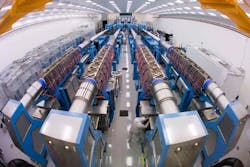DOE awards Sydor Technologies $1.15M Phase 2 SBIR grant to continue work with the Lab for Laser Energetics (LLE) on Fast Photodiode development
ROCHESTER, N.Y., [Oct 26, 2022] ‒ Sydor Technologies, a global leader in advanced x-ray detectors, was awarded an new $1.15M Phase II SBIR grant from U.S. Department of Energy (DOE) to continue development of new Fast Photodiode with better time resolution and integrated readout electronics for laser characterization, synchrotrons, and fusion experiments. The picosecond timing information, tunable wavelength sensitivity, and compact commercial design will benefit fusion and high energy density physics facilities conducting ultra-fast timing experiments that require good quantum efficiency in deep UV and x-ray regimes.
As an example, beam timing measurements at free electron laser facilities monitor timing for electron bunch pulses with 100 kHz repetition rates in laser-driven shock, plasma, and optical/UV pump-probe experiments. These measurements require detector rise-fall times to be below 50 ps to monitor coarse timing. Device size is another important factor, particularly in the crowded and complex target chambers of fusion facilities. The need for robust, condensed packaging, and picosecond time resolution extends to fields of laser characterization and synchrotrons. There is currently no fast photodiode available in the market with a UV/x-ray response time < 50 ps. In addition, readout electronics that can actually take advantage of the fast time response are not readily available.
The main objective of Phase II will be to develop and test integrated readout electronics with the new photodiode prototype developed in Phase I. This effort will review Phase I designs, develop high speed analog front end electronics, and provide system integration with a versatile software interface. A parallel research vein of the project will continue advancing diode fabrication. This will focus on studying alternative substrate compositions that have more uniform lattice constants and study the performance of alternatives to metal-semiconductor-metal material structures. Both research efforts will have long term manufacturing benefits if they prove successful and commercially robust.
“The fast photodiode fills a niche requirement in fast timing measurements that is not currently met. Bringing this to the market offers a solution for laboratories that are not able to secure larger and more costly timing measurement technologies, and will allow researchers the opportunity to increase the lines of sight that are monitored in experiments.”
Dr. Valerie Fleischauer, Principal Investigator and Development Scientist at Sydor Technologies
A commercially supported fast photodiode with sub-50 ps resolution will enable a new era of cost effective fast timing measurements for pulse timing and pump-probe experiments. Free electron laser facilities and pulsed soft x-ray source researchers will actually be able to measure pulse to pulse variations during experiments, which can provide game changing information to single shot event results. Larger facilities observing dozens of UV and soft x-ray pulses simultaneously can also take advantage of the integrated electronics, eliminating the need to allocate expensive oscilloscopes to a single application. The continued partnership with the Lab for Laser Energetics (LLE) will provide innovative technology solutions that will help expand research opportunities.
About Sydor Technologies
Sydor Technologies is a global leader in providing complex measurement solutions that generate critical results for the world’s most advanced applications in the defense, energy, ballistics, security, space, and research industries. Established in 2004, Sydor Technologies is headquartered in Rochester, NY and now supplies systems and support in over 33 countries. For additional information, please visit www.SydorTechnologies.com
